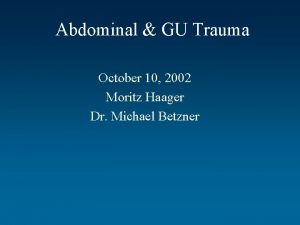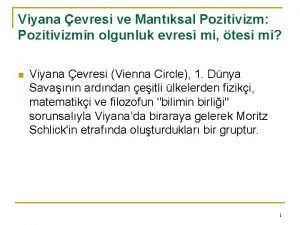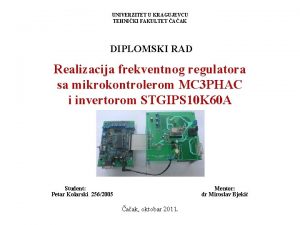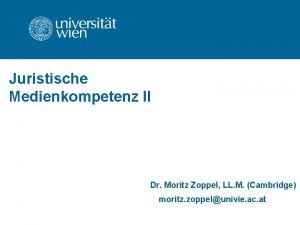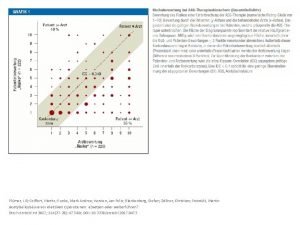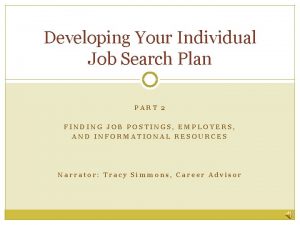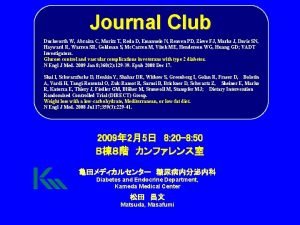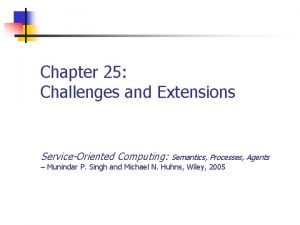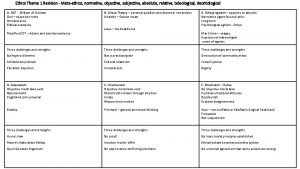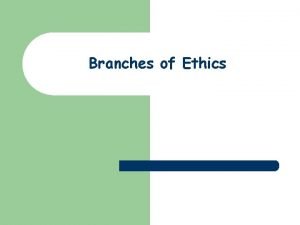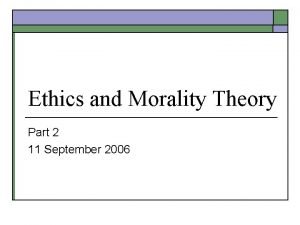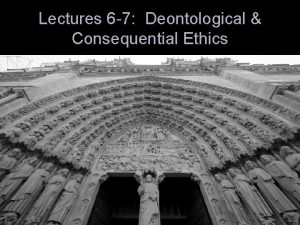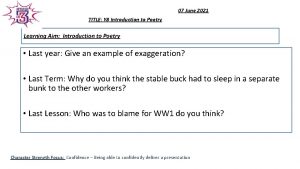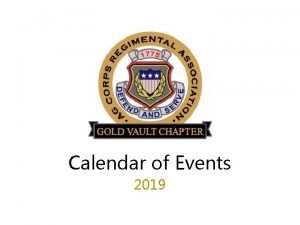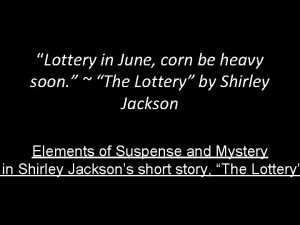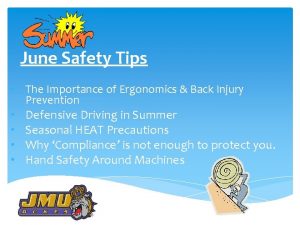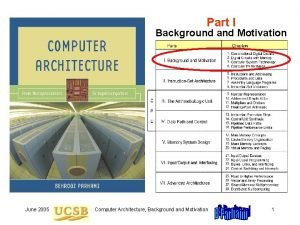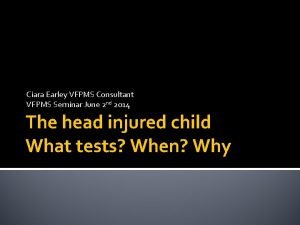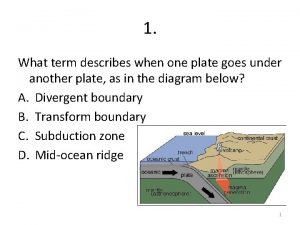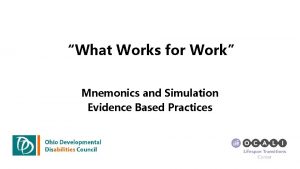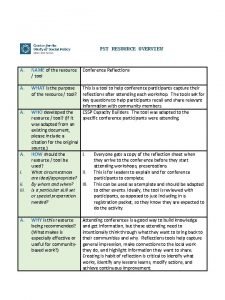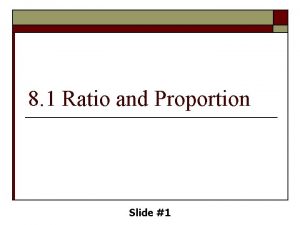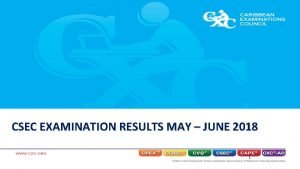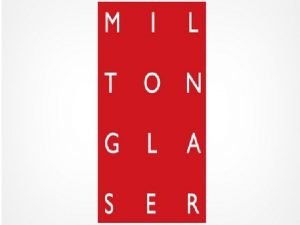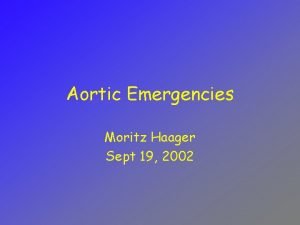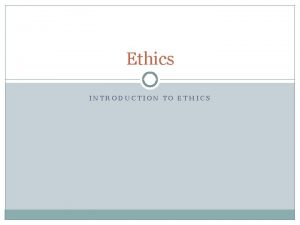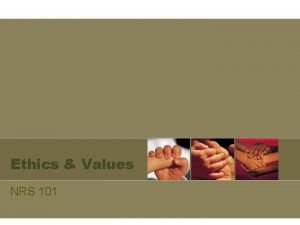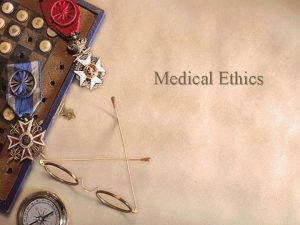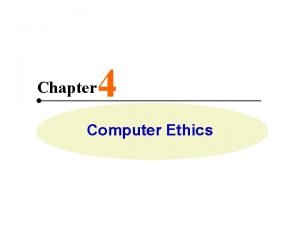ETHICS Part I June 5 2003 Moritz Haager
















































































- Slides: 80

ETHICS Part I June 5, 2003 Moritz Haager PGY-2 Dr. Carol Holmen

Ethics vs. . Law “. . ethics and law are not equivalent. Adherence to the law does not result in ethical behaviour, and ethical behaviour may not be covered by the law or may in fact be contrary to law or policy…. ethical duties typically exceed legal duties, and in some cases, the law mandates unethical conduct” • Derse. Emerg Med Clin North Am. 1999; 17(2): 30725

Ethics vs. Law Ø Law l l A formal expression of a social ethical consensus that sets a minimal standard of conduct Does not cover large areas of conduct Ø Ethics l l Branch of philosophy dealing with human conduct which acts as a moral repository of societal norms Less formal but more pervasive than law

What is unique about ED ethics? Most literature and discussion focused on nonacute setting Ø Pts present w/ rapid change in health Ø Little continuity of care / familiarity w/ pt Ø Lack of reliable information Ø Need to make rapid potential life or death decisions w/ limited information Ø Pts often not in ED of their own volition Ø Pts often impaired, noncompliant, or hostile Ø

What is an Ethical Dilemma? Ø Deciding which of 2 or more choices provides the greater overall good l l Autonomy vs. justice Confidentiality vs. public duty Beneficience vs. non-maleficience etc

Ethical Models Ethics Deontologic Theory Consequentialist Theory Relies on ‘fundamental’ rules e. g. first, do no harm Based on predicted outcomes e. g. do more good than bad

Fundamental Ethical Principles Ø 1. Preservation of Life l l Beneficience Non-maleficience Ø 2. Respect Autonomy Ø 3. Justice Ø 4. Truthfulness

Preservation of Life Ø Beneficience l l Acting in the pts benefit (= doing “good”) Alleviation of suffering Ø Nonmaleficience l Primum non nocere (first do no harm)

Autonomy Ø From Greek for ‘self-rule’ = Patient right to self-determination Ø Respecting vs. . creating autonomy l l Respecting = following pts wishes Creating = allowing pt to make a choice e. g. informed consent Ø Autonomy vs. paternalism Ø Benign paternalism l Making therapeutic decisions for incompetent pts in good faith

Justice Ø Complex concept E. g. resource allocation Ø 3 major types: l Egalitarian • equal access for all l Libertarian • social or economic ability should be allowed to determine access l Utilitarian • combines features of above to maximize public utility (Canadian System)

Case 1 Ø A 83 you Punjabi male is brought to the ED for ‘constipation’. He looks cachexic and dehydrated but is oriented and able to communicate. Ø Physical exam reveals an enormous hard irregular mass in the abdomen which is almost certainly cancerous.

Case 1 You call the radiologist to arrange an abdominal CT. You don’t realize the son is standing behind you as you relate your suspicion about the “cancer”. Ø After you hang up the son approaches you and asks you not to tell his father the Dx because he is very afraid of death and would not want to know. In India the word Cancer is like a death sentence he tells you. He feels that telling him would destroy his fathers quality of life. Ø

Truthfulness Ø Ø Trust b/w pt and physician Is truth always best? Straightforward? l l l Ø Therapeutic privilege l l Ø Cultural differences Impact of disease Gradual vs. . immediate disclosure Concept that a physician may withhold information if doing so would result in harm to the pt (nonmaleficience) Becoming a historical concept Withholding information, at least temporarily, may be justified, BUT only if there are compelling & defensible reasons

Mc. Master Decision Model List the alternative courses of action 2. Assess each alternative in 3 spheres: 1. Ø Ø Ø Medical Patient Legal Apply relevant ethical principles to each 4. Justify each choice as a moral statement 5. Formulate a conclusion 3.

Iserson Model Have you already dealt w/ a similar problem? Do you have a rule for it? 2. Is there a safe time-buying option? 3. If immediate decisions needed: 1. 2. 3. Impartiality test – would you want this done to you? Universality test – would you want this done in all similar situations? Interpersonal Justifiability test – can you strongly justify your actions to others?

Case 2 Ø You are taking care of a 25 yo female suffering from acute traumatic C 1 on 2 dislocation with complete cord transection. She is ventilator-dependant and a complete quadriplegic with no chance of recovery. She is alert enough to answer questions through eye opening and closing.

Case 2 Ø Her husband indicates to you that they wish for the ventilator to be turned off. They had discussed this hypothetical situation in the past as the family knows Christopher Reeves who used to ride horses at their ranch She confirms this when you ask her if this is true.

Consent Ø The pts right to agree to, OR refuse a medical treatment (autonomy) Ø Requires physicians to inform pts about the potential consequences of both accepting and refusing a treatment

Implied vs. . Explicit Consent Ø Implied Consent l l Pts actions in keeping w/ agreeing to Tx E. g. Pt rolls onto side and pulls down pants when told of need to perform a DRE Ø Explicit Consent l l l Verbal or written, and documented on chart More involved discussion of risks, benefits, and alternatives Should be obtained by person doing procedure

Components of Consent Possession of decision-making capacity 2. Provision of pertinent information about the proposed therapy on which to base a decision 3. Consent is voluntary, and obtained w/o coercion or manipulation. 1.

Guidelines for informed consent Discuss procedure including anticipated impact, significant risks, and alternatives l Encourage questions l Explain likely outcome if treatment is not provided without resorting to coercion l Specifically address individual concerns l Adhere to above for all patients even if they seem prepared to accept any treatment l

Assault vs. . Battery Ø Assault l Threatening to touch someone Ø Battery l l Touching someone without that persons agreement Any intervention in the ED provided w/o the pts consent in situations other than those where consent is not required

Exceptions to Need for Consent Ø Based on concept of beneficience l Emergencies: If immediate threat to life or limb, and unable to give consent • Unconscious trauma victim l Person lacking capacity and at acute risk • Intoxicated drug OD pt wanting to leave • May require invocation of Mental Health Act l Treatment of minors • 12 yo Jehovah's witness w/ acute blood loss l Public Health Regulations • Mandatory reporting laws

Age of Consent Ø Ø No age of consent in Canadian tort law Provincial legislation for age of consent: l PEI • 18 yo or married (for surgery) l NB • 16 yo or younger if ‘competent’ l PQ • 14 yo l SK • 18 yo or married (for surgery) l BC • 16 yo if unable to obtain parental consent; need 2 nd physician to provide written opinion of necessity of Tx

Case 3 Ø 14 yo female is brought in by her mother. A friend of the girl has just phoned the mother to say that she had gotten drunk, done drugs, and then had sex with a nineteen year old. The pt denies all this. Mom demands a drug screen AND pelvic examination. She firmly states that as the pt is a minor, and she the parent, you must abide by her wishes. Do you? What if the girl refuses the blood and urine tests, and pelvic exam? Are you obliged to refer her to the sexual assault team? Are you obliged to notify the police?

Case 4 Ø A 12 yo girl is brought to the ED by her mother c/o fever & dysuria. The pt does not want her mom present during the interview or exam. She is pre-menarchal, and denies being sexually active, or sexual or physical contact against her will. Her temp is 38. 0. Superficial genital exam reveals multiple labial ulcerations and malodorous vaginal discharge.

Case 5 Ø A 16 yo female is brought to the ED by her mother for abd pain, vomiting, and PV bleeding. You examine her in private. She admits to consensual sexual activity. A urine pregnancy test is +ve, and she has a tender R adnexal mass. U/S confirms a ectopic pregnancy. She understands the need for intervention and is willing to see O & G but insists you not tell her mom.

Case 6 A 70 yo man with gangrene of R foot + leg from a diabetic ulcer is in your ED. He is requesting a Rx for abx & painkillers. You tell him that you think he should come into hospital and see a surgeon. He refuses this saying he does not want his leg amputated. “better to die than lose your independence” he tells you. Ø His daughter is present and argues with him vehemently. At one point she tells him “you can’t go on like this, all cooped up by yourself in that house not taking care of yourself”. She tells you he has been depressed since his wife’s death 2 yrs ago. Ø

Capacity Ø = Ability to comprehend & process: l l Ø Information about the treatment or test Potential consequences of acceptance or refusal Capacity can fluctuate with situation & time l Assess on sliding-scale: the more serious the decision, the more competent the pt should be Age does not necessarily preclude capacity Assessment of capacity poorly studied & subject to bias Ø Few statutory laws other than those regarding formal admissions for psychiatric pts to guide you Ø Ø

Impaired Capacity Ø Examples of impaired capacity l l l Intoxication Organic brain disease (e. g. Alzheimer’s) Minors Suicidal pts Other psychiatric illnesses

Aid to Capacity Evaluation (ACE) Ø Tool for systematic evaluation of capacity developed at U of T by experts in law, ethics, and medicine Ø Scores 7 areas as ‘yes, no, or unsure’ Ø Requires identifying & addressing any communication barriers Ø Done in conjunction w/ discussing risks, benefits, & alternatives of proposed Tx Ø ACE questionnaire available at http: //www. utoronto. ca/jcb/_ace/ace(fm). htm

ACE Questions Ø Ability to understand: l l l Current medical problem Proposed Tx Alternative therapies (if any) Option of refusing any Tx Reasonably foreseeable consequences of accepting proposed Tx Reasonably foreseeable consequences of refusing proposed Tx Ø Is the person’s decision influenced by: l l Depression Delusions or psychosis

ACE Conclusions Ø Final assessment subjective, but based on score in prior areas l Pt should demonstrate ability to understand relevant info AND possible consequences Ø Clinician designates pt as one of: l l Definitely capable Probably incapable Definitely incapable

Validity of ACE Ø Cross-sectional study of 100 inpatients w/ questionable capacity facing serious medical decisions Ø Assessed by residents & research nurse using ACE + MMSE, general impression of attending physician, and formal assessments 2 separate experts Ø Compared results of each

Validity of ACE Ø Results l l l ACE took ~15 min to administer Agreement b/w ACE and expert opinion was sig higher (k = 0. 90 -95) than the general impression of attending physician (k = 0. 86) MMSE scores of 0 -16 correlated sig w/ incapacity (k = 0. 93) A MMSE score of 0 -16 combined w/ an ACE score of probably or definitely incapable resulted in post-test prob of 96% for incapacity A MMSE score of >24 combined w/ an ACE score of probably or definitely capable resulted in post-test prob of incapacity of 3%

Validity of ACE Ø Conclusions l l l ACE & MMSE both agree well w/ expert opinion Indeterminate results (probably capable or incapable; MMSE score 17 – 23) correlate more poorly and should prompt alternative evaluation Combining ACE and MMSE preferable • Etchells et al. J Gen Intern Med. 1999; 14: 27 -34

Case 7 Ø An ill-appearing 2 -year-old with a fever and stiff neck appears to have meningitis. His parents refuse a lumbar puncture on the grounds that they have heard spinal taps are extremely dangerous and painful. They refuse treatment and investigation, saying, " We'd prefer to take him home and have our minister pray over him. "

Case 8 Ø A 5 -year-old child has just had his second generalized tonic-clonic seizure in a 4 month period. You have recommended starting an anticonvulsant. The parents have concerns about the recommended medication and would prefer to wait and see if their son has more seizures. How should you respond to the parents request?

Treatment Refusal Ø A person of proper mental capacity has the right to refuse even life-saving Tx Ø A parent or guardian may NOT make this same decision for a minor in their charge Ø Written documentation corroborated by family members have been deemed sufficient grounds to withhold emergent therapy in an unconscious patient

Treatment Refusal The key question in the ED regarding refusal of treatment is whether the patient is competent to make this decision Ø Difficult area, but generally based on: Ø l l l Ø Set of values and goals Consistency in decision-making Ability to understand & communicate info Linguistic & conceptual skills Sufficient life experience Ability to reason Refusal of life-saving measures usually mandates assistance in determination of competency

Case 9 Ø A 50 yo male receiving palliative care for metastatic stomach CA is brought in by his family b/c of poor pain control and inability to tolerate PO feeds Ø His vitals are 37. 4 / 110 / 96/70 Ø He looks cachectic, jaundiced, dry, is drowsy & unable to answer Q’s or cooperate with exam Ø He has multiple metabolic abnormalities including renal failure on his lab work

Case 9 Ø His wife states that he did not wish for life- prolonging measures or resuscitation, only for “comfort and dignity” Ø His wife does not want you to start an IV, however his son & daughter argue that he is dehydrated and should not starve to death Ø How do you approach this?

Case 10 Ø A 79 yo male is brought to the ED from a nursing home in acute resp distress. Ø Recent admission records indicate COPD, end-stage RF, and dementia. He is nonambulatory. Ø On exam he is in sig resp distress. His vitals are 38. 0 / 130 / 140/90 / 30 / 79% on 40% O 2 Ø He is frail and unable to answer Q’s.

Case 10 Ø There is no documented code status anywhere Ø The only family member you can reach is a son who lives in Miami. He last saw his father 8 mo ago. The son informs you that his father would not want any aggressive treatment.

Substitute Decision Makers Ø Person chosen to make medical decisions on behalf of an incompetent pt Ø Role is to use “Substituted Judgment” to try and mirror what the pts wishes most likely would be

Substitute Decision Maker Ø Murky area in Canadian law: l family members probably not legally empowered to act as substitute decision makers unless specifically court appointed, although this is common practice Ø If no appointed SDM, use in rank order: l Court-appointed guardian spouse / partner child parent sibling other relative Ø If no one available need public guardian

Minors Ø “Mature Minor” l Minor capable of understanding the risks & benefits of a Tx are entitled to make autonomous decisions Ø “Emancipated Minors” l l Sub-group of mature minors Those who support themselves independently and live separately from their parents, are married, and / or serve in the armed forces.

Case Ø A 45 yo male is brought in by EMS for polydrug OD. He is intubated and placed on a ventilator for resp failure. Ø A suicide note is found on scene in which the pt claims he has the right to choose to die on his own terms given his Dx of ALS, that he is rational and not depressed, and that he will sue anyone resuscitating him.

Case Ø His common-law wife arrives with his ‘living will’. It was formulated 6 mo prior, witnessed and notarized. In it the pt clearly states that if he is “. . in a condition that is terminal with no reasonable hope of recovery I do not want heroic measures to prolong my dying. . ” Ø His wife states he would not want these interventions and demands you turn the ventilator off

Case 11 Ø An elderly man with end-stage emphysema presents to the emergency room awake and alert and complaining of shortness of breath. An evaluation reveals that he has pneumonia. His condition deteriorates in the emergency room and he has impending respiratory failure, though he remains awake and alert. A copy of a signed and witnessed living will is in his chart stipulates that he wants no "invasive" medical procedures that would "serve only to prolong my death. " No surrogate decision maker is available. Should mechanical ventilation be instituted? What if he presents confused and somnolent?

Advance Directive Ø Legal document outlining a pts wishes regarding their medical Tx in the event of becoming incapable of directing their care Ø May assign a person to be SDM in which case it is a “proxy directive” or “durable power of attorney” Ø Can be revoked by the pt at any time

Case 12 Ø A 16 yo female presents w/ PV bleeding and abd pain. She came alone. Ø By Hx & exam she is 10 wks pregnant and is having an incomplete abortion with sig bleeding Ø You discuss the situation with the pt and after discussing the options she states she wants a D & C

Case 12 Ø As you hang up the phone after talking to O & G the mother identifies herself to you and asks what is going on with her daughter. You ask her to speak with the pt. She returns stating her daughter has no idea what is going on and as the parent she demands to know what is wrong.

Case 13 Ø A 24 yo male presents w/ penile d/c. He admits to using the services of a prostitute on a recent business trip to Thailand. You feel he likely has gonorrhoea and Tx him accordingly. His wife is in the waiting room. He demands you keep his Dx confidential stating that it was a “one time thing” and if she knew it would ruin their marriage. You buy yourself some time by going to grab a prescription pad. Outside you are approached by his wife who asks what is the matter with her husband.

Case 14 Ø A 60 -year-old man has a heart attack and is admitted to the medical floor with a very poor prognosis. He asks that you not share any of his medical information with his wife as he does not think she will be able to take it. His wife catches you in the hall and asks about her husband's prognosis. Would you tell his wife?

Confidentiality Ø Pts has the right to hold the physician to secrecy regarding personal info EXCEPT where: l l l Doing so contravenes legal obligations Doing so may result in harm to others Doing so may result in harm to the pt AND the pt is incompetent Ø All reasonable steps must be taken to inform pt of intended breach of confidentiality

Case 15 Ø A 55 yo female is brought to the ED for decreased colostomy output and abdominal pain. She has a Hx of TAH & BSO for ovarian CA 5 yrs ago. She looks mildly unwell and has generalized abdominal tenderness, but is otherwise stable. An U/S shows peritoneal carcinomatosis. Your staff surgeon who has not seen the pt, shrugs and tells you to send her back to the peripheral hospital from where she came. When you ask him about what you should tell her he says “Nothing. Let the GP handle it”

Case 16 Ø You are about to go see your next pt who is here after a minor MVA when you are intercepted by her daughter in the hall Ø She tells you that her mother has cancer, but she has not told her of this and asks you to keep this secret. Ø On exam there is an obvious mass lesion on the left breast. As you are auscultating the pt asks you about the mass.

Case 17 Ø A 89 yo male is brought to the ED for cough & resp distress. Ø You find he has b/l pneumonia, chronic pulmonary edema, as well as a UTI Ø He was discharged 3 wks ago for CHF exacerbation with multiple complications Ø He was a full code status at that time

Case 17 Ø Despite treating him with Abx, diuretics, and O 2 his breathing continues to deteriorate. He starts to look more septic so you start him on bi. PAP and dopamine. Ø You discuss the situation w/ his wife. When you bring up code status she becomes upset and insists everything be done Ø Just then you are called into the resus room – your pt is in PEA

Case 18 Ø A 45 yo female of is brought to the ED w/ fever + cough. She is in a persistent vegetative state x 2 yrs following an MVA, lives in a nursing home and depends on a G-tube for nutrition. She is tachypneic and her O 2 sats are 86% on RA. You Dx her w/ pneumonia and start her on abx and O 2. As she looks unwell you broach the topic of code status. The family, who are Orthodox Jews, insist that she receive all measures including intubation & ICU care if necessary. Is this appropriate?

Medical Futility Ø Futility l action that is ineffective or w/o useful purpose Ø Medical futility l l Variety of definitions but none widely accepted based on largely subjective opinions as we often don’t really know the true efficacy of a treatment, nor can predict its success in a particular patient

Medical Futility Ø AHA ACLS guidelines for terminating resuscitation: l l l BLS & ALS have been attempted appropriately w/o ROSC or breathing Deteriorating pt condition despite maximal therapy precludes likelihood of recovery (e. g. septic shock in ICU) Disease states from which no successful resuscitation has been reported in welldesigned studies (e. g. metastatic CA)

Medical Futility Ø Schneidermann et al 1990 l l A treatment is futile if “…merely preserves permanent unconsciousness or …fails to end total dependence of intensive medical care” Efforts can be terminated, or care withdrawn w/o pt approval “. . when physicians conclude (either through personal experience, experiences shared with colleagues, or consideration of empiric data) that in the last 100 cases, a medical treatment has been useless”

Medical Futility Ø Brody and Halevy 1995 l Physiologic futility • failure to produce a physiologic response l Imminent demise futility • failure to prevent death in the very near future l Lethal condition futility • intervention not expected to impact fatal outcome in near future due to underlying condition l Qualitative futility • intervention not expected to result in an acceptable quality of life

Pro-futility arguments Ø Professional Integrity l Ø Professional Expertise l Ø Physicians should not be forced into providing treatments they believe offer no benefit or are potentially harmful Pts seek the advice of a physician regarding diagnosis and treatment options and would not normally expect to be offered Tx w/ little or no benefit Resource Stewardship l Selective use of limited resources to maximize societal benefit

Anti-futility Arguments Ø Respect for Pt Autonomy l Ø Prognostic Uncertainty l Ø Where the goals of Tx, or odds of success worth pursuing are perceived differently by the physician and the pt or substitute decision makers, the latter’s wishes should be respected Literature of critically ill pts suggests physicians are not good at accurately predicting outcomes making it difficult to justify withholding care based on this Lack of Societal Consensus on Futility l Unless universally agreed upon, no futility judgments should be imposed on unwilling subjects

Approach to Futility Ø Patient Preferences Ø Likelihood of medical benefit l Based on literature Ø Likelihood of non-medical benefits l Includes family needs, grieving process etc Ø Family Wishes Ø Potential Risks of Intervention l Risks to pt and healthcare workers

Demands for Inappropriate Care Ø Three groups: l Demands for ineffective Tx • E. g. antibiotics for common cold l Demands for effective Tx that supports a controversial goal • E. g. liver transplant for 104 yo pt w/ end-stage liver dz l Cases at the fringe of standard medical care • E. g. chelation therapy

Demands for Inappropriate Care Ø You are under no obligation to provide Tx that falls outside the standard of care, or those for which there is very poor evidence but which may be used by a small number of physicians Ø If an acute situation is complex, possibly inappropriate requests for life-saving measures should be respected

Demands for Inappropriate Care Ø Demands for effective Tx that supports a controversial goal l Most difficult situation Values of physician vs. . family / pt Autonomy vs. . distributive justice Ø Often requires extensive discussions & help l l l Hospital ethics committee Social workers Clergy

Case 19 Ø A 75 yo male is brought in by EMS. He was found comatose in his bed next to an empty bottle of barbiturates by a home care nurse. His son arrives and tells you his father has advanced lung CA with extensive bony mets which cause him intractable pain despite massive narcotic use. He is expected to die within the next 6 mo and has repeatedly stated the he is “ready to face the maker”. Your pt at that point goes into resp arrest. The son pleads with you not to intervene. “Please, just let him go. He wants to die…. . has he not suffered enough? ”

The BIG Question Ø Are some suicides reasonable decisions rooted in the concept of autonomy? l l l 90% of suicides felt to be associated w/ some form of mental illness on post-mortem review Beneficience in the form of intervention overrules pt autonomy in these cases based on the idea that the mentally impaired pt the lacks capacity Situations where an otherwise competent pt chooses suicide are less straightforward

Are there “good” reasons for a pt to commit suicide? Should these be respected? Ø Pro l l l A pt who has capacity has the right to selfdetermination & should not suffer the imposition of others moral beliefs If all other medical options (beneficience) have been exhausted then our next duty should be to avoid further harm (maleficience) We must clearly differentiate between our own moral belief system and the choices we would make for ourselves, and those of our pts

Are there “good” reasons for a pt to commit suicide? Should these be respected? Ø Con l l l Suicide is counter to the principle of preserving life Controversial whether suicide can truly represent a rational choice Not legally recognized as a right Rejected by most major religions In the ED in particular knowledge of the pt and their circumstances limited

Physician Assisted Suicide Ø Legal in Netherlands & Oregon Ø Not legal in Canada…yet Ø Impact on ED l l l Failed suicide attempts – who do we resuscitate? Family members demanding resuscitation Staff unable to comply with pts wish to die Conflict b/w members of health care team Conflict w/ institutional policy

Intervening in Suicide Ø Catch 22: the need to avoid 2 mistakes l l Intervening when it is not warranted Not intervening when it is warranted Ø Bottom line: l ~90% will have mental illness, combined with the lack of prior intimate knowledge of the pt alone should prompt intervention given the irreversibility of suicide

And finally…the biggest question Is this ethical, for healthcare workers to smoke?

THE END

Case 20 Ø 51 yo male presents w/ 2 hr CP Ø 2 mm STE in ant leads Ø Tx w/ ASA, nitro – r/o contraindications to thrombolysis Ø During risks & benefits discussion his pain resolves & ECG normalizes – CCU consult Ø 2 hrs later nurse tells you pt is attempting to leave b/c his pain has resolved and he is tired of waiting around
 Moritz haager
Moritz haager Moritz mueller swinburne
Moritz mueller swinburne Franz moritz wilhelm marc
Franz moritz wilhelm marc Terry moritz
Terry moritz Olgunluk evresi
Olgunluk evresi Sap
Sap Mc3phac
Mc3phac Vera stephan
Vera stephan Moritz zoppel
Moritz zoppel Robert plmer
Robert plmer Symplicity moritz
Symplicity moritz Moritz zoppel
Moritz zoppel Witwe bolte hund
Witwe bolte hund Picotdc
Picotdc Moritz zimmermann sap
Moritz zimmermann sap Moritz wefelscheid
Moritz wefelscheid Moritz zoppel
Moritz zoppel Sarah moritz fröndenberg
Sarah moritz fröndenberg Moritz matern
Moritz matern Beneficence
Beneficence Teleological ethics vs deontological ethics
Teleological ethics vs deontological ethics Factual inquiry in ethics
Factual inquiry in ethics Theological voluntarism
Theological voluntarism What is environmental ethics
What is environmental ethics Metaethics vs normative ethics
Metaethics vs normative ethics Three branches of ethics
Three branches of ethics Non cognitivism
Non cognitivism Descriptive ethics vs normative ethics
Descriptive ethics vs normative ethics Utilitarian vs deontological
Utilitarian vs deontological Micro and macro issues in engineering ethics
Micro and macro issues in engineering ethics The part of a shadow surrounding the darkest part
The part of a shadow surrounding the darkest part Part part whole
Part part whole Minitab adalah
Minitab adalah What is a technical description?
What is a technical description? Part part whole addition
Part part whole addition Parts of front bar
Parts of front bar Unit ratio definition
Unit ratio definition Welcome june blessings
Welcome june blessings February march april may june july
February march april may june july Good morning 1 june
Good morning 1 june June 22 to july 22
June 22 to july 22 1215 king
1215 king Summary period: june 2021 poem
Summary period: june 2021 poem June canavan foundation
June canavan foundation Companies in june
Companies in june Dr june james
Dr june james Geometry regents 2019
Geometry regents 2019 Tsc timetable
Tsc timetable June 2010 physics regents answers
June 2010 physics regents answers June too soon july stand by
June too soon july stand by June's journey
June's journey Lenore hetrick biography
Lenore hetrick biography 2019 june calendar
2019 june calendar Summary period: june 2021 jack
Summary period: june 2021 jack Nysedregents
Nysedregents Lottery in june corn be heavy soon page number
Lottery in june corn be heavy soon page number June 6th 1944
June 6th 1944 June preschool newsletter
June preschool newsletter The map shows that allied forces
The map shows that allied forces New irpwm june 2020
New irpwm june 2020 Junes portfolio includes 177 shares
Junes portfolio includes 177 shares 1 june children's day
1 june children's day June holley
June holley Flacs checkpoint b spanish exam june 2018 answers
Flacs checkpoint b spanish exam june 2018 answers June safety tips
June safety tips June 2005 calendar
June 2005 calendar Vfpms
Vfpms Simplissimus 3 june 1919
Simplissimus 3 june 1919 June cheetah wegener
June cheetah wegener Danswer
Danswer Life orientation grade7
Life orientation grade7 John 20 21 22
John 20 21 22 30 days has september april june and november
30 days has september april june and november June 23
June 23 Proper noun of day
Proper noun of day June 20 2008
June 20 2008 Nasa june 19 2008
Nasa june 19 2008 Cxc results 2018
Cxc results 2018 Lake june head start
Lake june head start Born june 26
Born june 26 June 23
June 23
